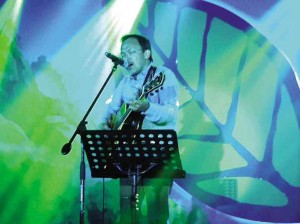The job gets tougher every year for the panel of judges in the Bayer Young Environmental Envoys (BYEE) competition.
You are asked to pick only four from 12 finalists. This is particularly distressing on a year when the kids are mostly marvelous, which this year happens to be. You wish you can send them all to Germany in November for that weeklong study tour that starts at the Bayer state-of-the-art facilities in Leverkusen.
The nice thing about the BYEE is that all 12 finalists go home feeling like winners. In many ways they are. Out of almost 70 college students aged 18 to 24 from all over the country, the stellar dozen who have made it as finalists are now part of a network of BYEE alumni. As a credential, the BYEE title is gold. It is given a lot of weight by organizations that recognize student achievements.
Not only that, the finalists have been brought to Manila for the judging and awarding ceremonies with all expenses paid by Bayer. Their passion for protecting the planet has been kindled through an ecocamp at Gawad Kalinga Enchanted Farm in Angat, Bulacan, where—this being the International Year of Water Cooperation per the United Nations— they’ve been given lecture and experiential exposures to a range of water life, from rivers to reservoirs to farming. Plus an opportunity to meet mural artist A. G. Sano who inspired their own dolphin mural. This live-in ecocamp, conducted all these 13 years by environmental experts from Ateneo de Manila University, is considered by many BYEE alumni as a life-changing experience.
And now comes the moment of reckoning at Dusit Thani Hotel where, as the judging is going on in the mezzanine, the ballroom is being readied for the evening awards ceremony. After
hours of project presentations and careful discussion among the judges, a runaway favorite emerges.
Ma-an Jane Diamos, a self-assured senior at the University of the Philippines-Manila, sways the judges overwhelmingly to her side with her research on species of bacteria that, to put it in layman’s terms, feed on plastic, the scourge of environmentalists.
The three other finalists, who will join Diamos and their counterparts from 19 countries to personally observe and experience the environmental protection practices in Germany, are: Katrina Ruth K. Verzola of Benguet University, Justine Win M. Cañete of John B. Lacson Foundation Maritime University (JBLFMU) and Glykie Cañete of University of Cebu-Banilad.
That the lucky four are all female warms the heart of this only female judge, although the others on the panel—Department of Environment and Natural Resources Forest Management Bureau Director Ric Calderon, Department of Science and Technology Environment Biotech Division Chief Rey Esguerra and Philippine Business for the Environment executive director and BYEE alumnus Bonar Laureto—are equally happy, having voted freely and fairly.
The rest of the BYEE finalists are Steven Carl Alayon (West Visayas State University), Daishel A. Balsomo (JBLFMU), Rother Johann Dadivas (WVSU), Ralph Rae Glindo (Technological Institute of the Philippines-QC), Karen Jane Imalay (JBLFMU), John Kit Masigan (St. Paul University-Tuguegarao), Juri Patetico (Bicol University) and Kate Marinela Tacadao (WVSU). May they continue to promote environmental awareness and green practices beyond this competition.
The BYEE program, now on its 13th year here, is a partnership between the United Nations Environmental Programme and Bayer, the global company known for its iconic Aspirin but is actually engaged in the manufacture of quite a range of research-intensive products for healthcare, crop science and innovative system solution.
Ma-an Jane Diamos
BS Biology
University of the Philippines-Manila
Project: Isolation and Propagation of Plastic-Reducing Bacteria.
Background: Annually, worldwide, 500 billion to a trillion plastic bags are used and discarded, littering the landscape as well as killing thousands of marine organisms. There’s a need for an efficient yet ecological solution to plastic waste accumulation.
Results: Through laboratory-based research, four bacteria species were successfully isolated— from samples sourced from the Payatas dumpsite—as capable of utilizing plastic as an energy source; research results were disseminated at a seminar called Trash Talk to increase awareness of such organisms among the faculty and students of UP and other universities.
Katrina Ruth K. Verzola
BS Developmental Communication
Benguet State University
Project: Saving 182 through Planting 182
Results: Conducted a reforestation activity by planting 360 Benguet pine seedlings in the communal forest in ancestral land in Shilan, La Trinidad, Benguet; held a preplanting seminar where 60 students of Tacdian Elementary School drafted a Panata sa Kalikasan; seedlings were monitored after two months and found to be robust; the community has requested that the replanting become an annual activity.
Justine Win M. Cañete
BS Information Technology
John B. Lacson Foundation Maritime University
Project: LOGS: League Of Green Screenagers
Background: “Screenagers” or the youth who are exposed a lot to the computer screen learn quickly through computer games. Can an e-learning project teach them about the need to protect the environment and transform them into green warriors for the planet?
Results: Created an e-tutorial on the environment and two games—Tickle Your Mind and Dispose It Properly—to assess what the user has learned; integrated LOGS into the university
Glykie Cañete
BS Tourism
University of Cebu-Banilad
Project: K to Green Project
Background: There was preschool facility shortage and garbage problem in Barangay Budla-an in Cebu as well as lack of environmental awareness and cooperation among the residents.
Results: Relocated the Budla-an preschoolers to a bigger, repainted classroom; recycled plastic bottles into pots and assorted waste into hanging decor; produced an environmental drama titled “Kiddie Plants vs. Zombies” that used recycled material for costumes; taught the kids how to plant; engaged parents to support their children’s newfound advocacy.
